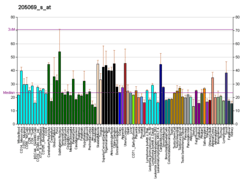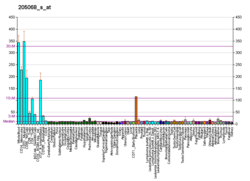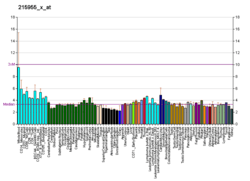ARHGAP26
Rho GTPase activating protein 26 (ARHGAP26) also known as GTPase Regulator Associated with Focal Adhesion Kinase (GRAF) is a protein that in humans is encoded by the ARHGAP26 gene.[5][6][7]
Function
GRAF1 is a multidomain protein that is necessary for the CLIC/GEEC endocytic pathway.[8] By virtue of an N-terminal BAR domain, GRAF1 sculpts the endocytic membranes of this pathway into 40 nm diameter tubules and vesicles that allow uptake of extracellular fluid, GPI-linked proteins and certain bacterial exotoxins into cells. The role of dynamin in the CLIC/GEEC pathway is controversial, but GRAF1 interacts strongly with this protein and acute inhibition of dynamin action abrogates CLIC/GEEC endocytosis. There are several members of the GRAF family of proteins, including GRAF2, GRAF3, and oligophrenin, all of which likely playing similar roles during clathrin-independent endocytic events. Mutations of both GRAF1 and oligophrenin are strongly implicated in causing human disease (leukaemia and mental retardation, respectively). Recently, autoantibodies to ARHGAP26 have been implicated in autoimmune cerebellar ataxia.[9][10][11]
Interactions
References
- 1 2 3 GRCh38: Ensembl release 89: ENSG00000145819 - Ensembl, May 2017
- 1 2 3 GRCm38: Ensembl release 89: ENSMUSG00000036452 - Ensembl, May 2017
- ↑ "Human PubMed Reference:".
- ↑ "Mouse PubMed Reference:".
- ↑ "Entrez Gene: ARHGAP26 Rho GTPase activating protein 26".
- ↑ Hildebrand JD, Taylor JM, Parsons JT (June 1996). "An SH3 domain-containing GTPase-activating protein for Rho and Cdc42 associates with focal adhesion kinase". Mol. Cell. Biol. 16 (6): 3169–78. PMC 231310. PMID 8649427.
- ↑ Taylor JM, Macklem MM, Parsons JT (January 1999). "Cytoskeletal changes induced by GRAF, the GTPase regulator associated with focal adhesion kinase, are mediated by Rho". J. Cell Sci. 112 (2): 231–42. PMID 9858476.
- ↑ Lundmark R, Doherty GJ, Howes MT, Cortese K, Vallis Y, Parton RG, McMahon HT (November 2008). "The GTPase-activating protein GRAF1 regulates the CLIC/GEEC endocytic pathway". Curr. Biol. 18 (22): 1802–8. doi:10.1016/j.cub.2008.10.044. PMC 2726289. PMID 19036340.
- ↑ Jarius S, Wandinger KP, Horn S, Heuer H, Wildemann B (2010). "A new Purkinje cell antibody (anti-Ca) associated with subacute cerebellar ataxia: immunological characterization". J Neuroinflammation. 7 (1): 21. doi:10.1186/1742-2094-7-21. PMC 2848133. PMID 20226058.
- ↑ Jarius S, Martínez-García P, Hernandez AL, Brase JC, Borowski K, Regula JU, Meinck HM, Stöcker W, Wildemann B, Wandinger KP (Jan 2013). "Two new cases of anti-Ca (anti-ARHGAP26/GRAF) autoantibody-associated cerebellar ataxia". J Neuroinflammation. 10 (1): 7. doi:10.1186/1742-2094-10-7. PMC 3549891. PMID 23320754.
- ↑ Doss S, Nümann A, Ziegler A, Siebert E, Borowski K, Stöcker W, Prüss H, Wildemann B, Endres M, Jarius S (15 Feb 2014). "Anti-Ca/anti-ARHGAP26 antibodies associated with cerebellar atrophy and cognitive decline". J. Neuroimmunol. 267 (1–2): 102–4. doi:10.1016/j.jneuroim.2013.10.010. PMID 24439423.
- ↑ Shibata H, Oishi K, Yamagiwa A, Matsumoto M, Mukai H, Ono Y (2001). "PKNbeta interacts with the SH3 domains of Graf and a novel Graf related protein, Graf2, which are GTPase activating proteins for Rho family". J. Biochem. 130 (1): 23–31. doi:10.1093/oxfordjournals.jbchem.a002958. PMID 11432776.
Further reading
- Ramakers GJ (2002). "Rho proteins, mental retardation and the cellular basis of cognition". Trends Neurosci. 25 (4): 191–9. doi:10.1016/S0166-2236(00)02118-4. PMID 11998687.
- Borkhardt A, Bojesen S, Haas OA, Fuchs U, Bartelheimer D, Loncarevic IF, Bohle RM, Harbott J, Repp R, Jaeger U, Viehmann S, Henn T, Korth P, Scharr D, Lampert F (2000). "The human GRAF gene is fused to MLL in a unique t(5;11)(q31;q23) and both alleles are disrupted in three cases of myelodysplastic syndrome/acute myeloid leukemia with a deletion 5q". Proc. Natl. Acad. Sci. U.S.A. 97 (16): 9168–73. doi:10.1073/pnas.150079597. PMC 16840. PMID 10908648.
- Dias Neto E, Correa RG, Verjovski-Almeida S, Briones MR, Nagai MA, da Silva W, Zago MA, Bordin S, Costa FF, Goldman GH, Carvalho AF, Matsukuma A, Baia GS, Simpson DH, Brunstein A, de Oliveira PS, Bucher P, Jongeneel CV, O'Hare MJ, Soares F, Brentani RR, Reis LF, de Souza SJ, Simpson AJ (2000). "Shotgun sequencing of the human transcriptome with ORF expressed sequence tags". Proc. Natl. Acad. Sci. U.S.A. 97 (7): 3491–6. doi:10.1073/pnas.97.7.3491. PMC 16267. PMID 10737800.
- Ishikawa K, Nagase T, Suyama M, Miyajima N, Tanaka A, Kotani H, Nomura N, Ohara O (1998). "Prediction of the coding sequences of unidentified human genes. X. The complete sequences of 100 new cDNA clones from brain which can code for large proteins in vitro". DNA Res. 5 (3): 169–76. doi:10.1093/dnares/5.3.169. PMID 9734811.
- Billuart P, Bienvenu T, Ronce N, des Portes V, Vinet MC, Zemni R, Roest Crollius H, Carrié A, Fauchereau F, Cherry M, Briault S, Hamel B, Fryns JP, Beldjord C, Kahn A, Moraine C, Chelly J (1998). "Oligophrenin-1 encodes a rhoGAP protein involved in X-linked mental retardation". Nature. 392 (6679): 923–6. doi:10.1038/31940. PMID 9582072.
- Taylor JM, Hildebrand JD, Mack CP, Cox ME, Parsons JT (1998). "Characterization of graf, the GTPase-activating protein for rho associated with focal adhesion kinase. Phosphorylation and possible regulation by mitogen-activated protein kinase". J. Biol. Chem. 273 (14): 8063–70. doi:10.1074/jbc.273.14.8063. PMID 9525907.
- Pillay TS, Sasaoka T, Olefsky JM (1995). "Insulin stimulates the tyrosine dephosphorylation of pp125 focal adhesion kinase". J. Biol. Chem. 270 (3): 991–4. doi:10.1074/jbc.270.3.991. PMID 7836419.
External links
- ARHGAP26 Info with links in the Cell Migration Gateway
- Human ARHGAP26 genome location and ARHGAP26 gene details page in the UCSC Genome Browser.









